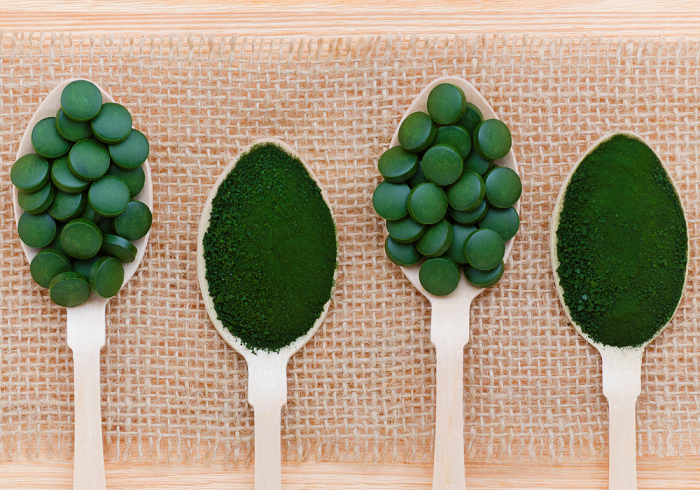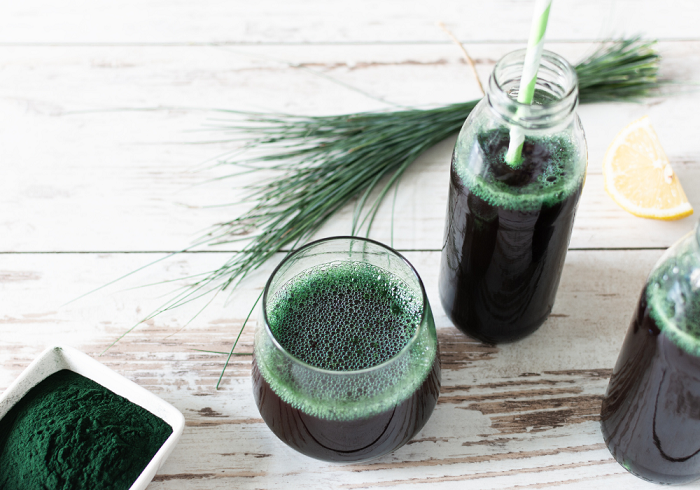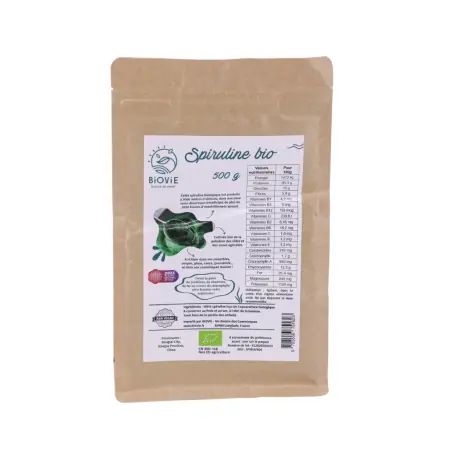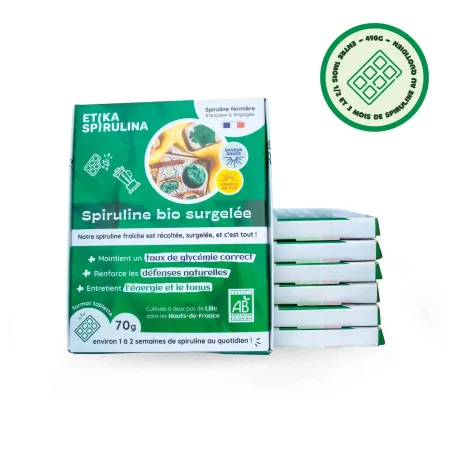The spirulina is a blue-green microalga that is considered a superfood Due to its high content of proteins, vitamins, essential minerals, and a blend of nutrients and active principles, it is neither of animal origin nor of plant origin, but rather of microbial origin. It has been consumed for centuries in certain cultures, but it is only recently that it has become popular in the West as a dietary supplement and as an ingredient in smoothies and energy bars because it is an excellent source of vitamin B2, which plays a role in hair health, and vitamin B12. It is considered one of the nutrient-rich foods on the planet, and its potential benefits for the body have been studied for several decades, making it the ideal food for good health due to its nutrient-rich composition. In this article, we will explore the various uses of spirulina.
What is the best way to take spirulina ?
Spirulina can be incorporated into your diet in various ways due to its beneficial effects, and this depends on your personal preferences and the reasons why you want to take it. To have a nutrient-rich diet, here are some common options for taking spirulina:
- It is consumed as a dietary supplement and can be found in the form of spirulina tablets or capsules. Spirulina supplements can increase the intake of essential nutrients and support overall health in cases of dietary deficiencies. It is important to follow the instructions on the packaging of dietary supplements for the recommended dosage.
- It can be used in cooking for a healthy and balanced diet, and it is an excellent source of vitamins. In this case, we choose the spirulina powder which can be used as an ingredient in a variety of recipes thanks to its valuable nutrients, including smoothies, salad dressings, and soups. It is important to note that spirulina has an earthy and slightly salty taste, so it is best to use it in small quantities at first to avoid overwhelming the flavor.
- It is also used in cosmetics in skincare products such as face masks due to its antioxidant properties, which can reduce oxidative stress caused by an excess of free radicals in the body, often associated with premature aging and certain chronic diseases. You can also find shampoos and soaps containing spirulina for its hair health benefits, thanks to its antioxidant properties that help combat dandruff and slow down skin aging.
- There are also other forms of spirulina, such as spirulina in twigs, spirulina in petals, or spirulina in flakes: spirulina in twigs is often used to be mixed into smoothies or drinks; spirulina in petals is commonly added to salads or dishes; and spirulina in flakes is often consumed on its own or sprinkled on foods as a nutritious condiment.
- You can also use artisanal spirulina, which emphasizes the natural and authentic character of this superfood. Many enthusiasts of powdered artisanal spirulina prefer this variety for its unique taste and the guarantee of an exceptionally high-quality product. Therefore, using artisanal spirulina allows you to benefit from a superior quality product that is natural, environmentally friendly, and offers a unique taste experience.

How much spirulina should be taken per day ?
The recommended daily dose of this nutrient-rich food derived from algae depends on several factors, including the person's age, sex, and overall health. Generally, the daily dose ranges from 1 to 3 grams per day, which is equivalent to about 1 to 2 teaspoons of spirulina powder, or 2 to 6 tablets per day of 500 mg each for a dietary supplement.
It is recommended not to start consuming spirulina with a high dose. Begin with small amounts and gradually increase the dose over time to avoid side effects such as digestive issues. However, it is important to note that the daily dose can vary depending on the manufacturers and products, so it is crucial to follow the instructions on the packaging for better assimilation of this product in the body. Consult a healthcare professional before starting to take this edible microalga and do not exceed the recommended daily dose indicated on the product.
With which foods should you consume spirulina ?
Spirulina can be consumed with a variety of foods to enhance its flavor and health benefits. Thanks to the nutritional composition of this superfood, which is rich in active ingredients and a good source of iron, it can cover up to 50% of our daily needs. It is recommended to pair it with a source of vitamin C for better iron absorption, as iron is more easily absorbed in its presence. Vitamin C can be found in fresh fruits like kiwi, oranges, and lemon, which are rich in vitamin C. For example, you can press them and drink them as fruit juice.
It should be noted that you should not associate spirulina with foods that diminish its effect by reducing the absorption of the iron contained in this micro-algae, such as coffee or tea. Therefore, it is better to space out their consumption and that of spirulina by several hours.
How to cook spirulina ?
Spirulina can be used in a variety of recipes to add an extra dose of nutrients. Here are some recipe ideas for cooking with this edible blue-green algae:
Smoothies: Add a teaspoon of spirulina powder to your morning smoothie for an extra dose of protein, vitamins, and minerals. You can start your day full of energy thanks to its high nutrient content. You can also add fruits, vegetables, and plant-based milk to create a healthy and tasty drink for a rich and nutritious diet.
Pesto: Add a tablespoon of spirulina powder to your homemade pesto for a nutrient-rich sauce. Blend basil leaves, garlic, nuts, and olive oil with spirulina powder to create a delicious sauce to serve with pasta or vegetables.
Soups and dishes with sauce: You can add a small amount of spirulina powder to your soup or saucy dishes. You can especially mix it into a lentil-based soup for an extra dose of protein. It is best to add the spirulina at the end of cooking because heat could alter the valuable nutrients present in spirulina.
Desserts: Add spirulina to your desserts for a touch of color and nutrients. Spirulina can be used in smoothie bowls, plant-based ice creams, energy bars, and cakes to add a unique and slightly salty flavor. If you're not a fan of the strong taste of powdered spirulina, we recommend using the fresh spirulina or frozen. Fresh spirulina has all the nutritional benefits of spirulina but with a neutral taste. Its flavor is mild and enhances the "umami" aspect of your dishes. Fresh spirulina is also easier to use because its texture is similar to that of fresh cheese. You can also use spirulina in the form of twigs or spirulina. in sequins because they undergo the least transformation.
Attention If you come across low-quality spirulina, it may have an abnormal color, an unpleasant taste, and undesirable contaminants. Therefore, it is important to ensure that you choose high-quality spirulina from organic stores. Sometimes, you may find spirulina with a blue color due to the presence of a natural pigment called phycocyanin, which is a powerful antioxidant.

How long does a spirulina treatment last ?
In general, a spirulina treatment can last from 3 weeks to 3 months. It is recommended to undertake this treatment during periods of overwork because spirulina helps combat fatigue, improves athletic performance for athletes, and enhances overall health in general. It is preferable to take spirulina as a treatment during the inter-season, that is, in spring or autumn, or when your body feels the need.
If you choose to undergo a 3-month treatment, it is necessary to take a one-week break every 3 weeks to allow your body to absorb and make the most of all the nutrients present in spirulina. However, it is important to note that spirulina is a dietary supplement and should not be considered a substitute for a balanced diet.
What are the contraindications of consuming spirulina ?
Although spirulina is considered a superfood with many health benefits, there are certain contraindications to consider before starting to consume it. Here are a few:
Allergies: People who are allergic to seafood or algae (chlorella, wakame, etc.) may also be allergic to spirulina. This food is rich in nucleic acid, which the body converts into uric acid. For individuals with high levels of this acid, who generally suffer from gout, it is therefore advisable not to consume this blue-green algae to avoid any adverse effects.
Autoimmune disorders: Spirulina can stimulate the immune defenses, which can be beneficial for some people but may be problematic for individuals with autoimmune disorders such as lupus, multiple sclerosis, and rheumatoid arthritis. It is important to consult a healthcare professional before taking spirulina if you suffer from this condition.
Thyroid disorders: Spirulina contains iodine, but its amount can vary depending on the source and cultivation method, so it can affect thyroid function. Excessive iodine consumption can worsen the symptoms of hypothyroidism or hyperthyroidism.
Pregnancy and breastfeeding: There is a lack of scientific data on the effects of spirulina during pregnancy and breastfeeding, so it is recommended that pregnant or breastfeeding women consult a healthcare professional before taking spirulina to avoid any adverse effects. It is also important to note that spirulina can cause interactions with certain medications, particularly those that affect the immune system, so it is important to consult your doctor before starting to take spirulina if you are on medication.










